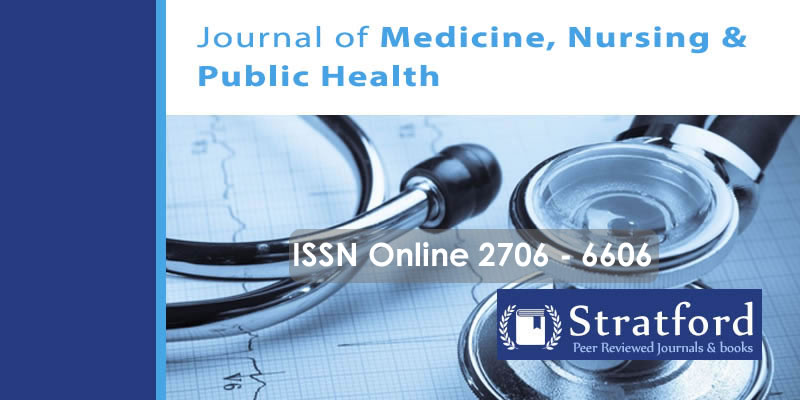Labor Related Factors That Contribute to Surgical Site Infections among Post Caesarean Section Mothers in Thika Level 5 Hospital
DOI:
https://doi.org/10.53819/81018102t4112Abstract
Caesarean Section is one of the most performed major surgical procedures carried out in obstetrics and constitutes about 15% of all deliveries worldwide, with Latin America being the highest at 29.2%. The study aimed to assess the labor related factors that contribute to surgical site infections among post caesarean section mothers in Thika Level 5 Hospital. The study design was a mixed unmatched case-control study which followed all mothers who had undergone caesarean section in maternity unit at Thika Level 5 Hospital and who had or did not have Surgical Site Infection from delivery up to two weeks post-delivery and nurse in-charges of maternity unit. The findings of the study informed the institution management on the determinants of surgical site infection following caesarean section, and took necessary precautions and surgical site care and management to prevent occurrence of surgical site infection in future. The findings revealed that prevalence of SSI was low among post Caesarean Section mothers at Thika Level 5 Hospital, with only 24.4% of the Caesarean Section mothers at Thika Level 5 Hospital found to have experienced SSI. The study in addition found that labor related factors had significant association with surgical site infections. Cases who had labor more than 8 hours were 3.12[95%CI=1.881 – 9.279, p<0.013] times more likely to have surgical site infections compared to controls. Cases who had ruptured membrane more than 24 hours were 3.85[95%CI=2.810 – 12.027, p=0.000] times more likely to have surgical site infections compared to controls. Finally, Cases whose indication of CS was previous CS scar were 7.41[95%CI=3.88 – 9.56, p=0.022] times more likely to have surgical site infections compared to controls. The study also concluded that most SSIs are preventable as Thika Level five hospital is employing different measures to reduce cases of SSI at the facility. It is thus recommended that the management of Thika Level 5 Hospital should pay a close attention to labor related factors that are likely to cause surgical site infections among post caesarean section mothers being admitted in the facility. The study also recommended that a continuous education program for healthcare workers and young new mothers is necessary and can be feasible and potentially successful, given the interest expressed by healthcare workers in the management of surgical site infections.
Keywords: Labor Related Factors, Surgical Site Infections, Post Caesarean Section
References
Andrew, B., O’Keeffe, T. & Stana, B. (2012) Oxford craniotomy infections database: a cost analysis of craniotomy infection. Br J Neurosurg. https://doi.org/10.3109/02688697.2011.626878.
Black, J. M., & Hawks, J. H. (2009). Medical-surgical nursing: Clinical management for positive outcomes. St. Louis, Mo: Saunders/ Elsevier.
Broex EC, van Asselt AD, Bruggeman CA, van Tiel FH. Surgical Site Infections: how high are the costs? J Hosp Infect. 2009 Jul;72(3):193-201. doi: 10.1016/j.jhin.2009.03.020.
Epub 2009 May 31. PMID: 19482375.Journal of Health, Medicine and Nursing. ISSN 2520-4025 (Online). Vol.3, Issue 4 No.1, pp 1-18,2018. www.iprjb.org
Himmelfarb Health Sciences Library, (2019) Case control - Study Design. https://himmelfarb.gwu.edu Imogene King Biography, (n.d.) Retrieved July 7, 2014, from
http://ing.clubexpress.com/content.aspx?page_id=22&club_id=459369&module_id=599 20
Melling, A., Hollander, D. A., & Gottrup, F. (2005). Identifying surgical site infection in wounds healing by primary intention. EWMA Position Document: Identifying criteria for wound infection. EWMA Journal 1609-2759.
Mpogoro, F. J., Mshana, S. E., Mirambo, M. M., Kidenya, B. R., & Gumodoka, B. (2014) Incidence and predictors of surgical site infections following caesarean sections at Bugando Medical Centre, Mwanza, Tanzania. Antimicrob Resist Infect Control. 2014; 3: 25. https://doi.org/10.1186/2047-2994-3-25
Teshager, M., Tilaye, W. A., Tesfaye, Y. C., & Antehun, A. A., (2017). Risk factors for surgical site infe ctions in obstetrics: a retrospective study in an Ethiopian referral hospital. Patient Safety in Surgery.
Urquhart, D. M., Hanna, F. S., Brennan, S. L., Wluka, A. E., Leder, K., Cameron, P. A., ... & Cicuttini, F. M. (2010). Incidence and risk factors for deep surgical site infection after primary total hip arthroplasty: a systematic review. The Journal of arthroplasty, 25(8), 1216-1222. https://doi.org/10.1016/j.arth.2009.08.011
Wloch, C., Wilson, J., Lamagni, T., Harrington, P., Charlett, A., & Sheridan, E. (2012). Risk factors for surgical site infection following caesarean section in England: results from multicenter cohort study. BJOG 2012; 119:1324-33. https://doi.org/10.1111/j.1471-0528.2012.03452.x
Zuarez-Easton, S., Zafran, N., Garmi, G., & Salim, R. (2017). Postcesarean wound infection: prevalence, impact, prevention, and management challenges. International journal of women's health, 9, 81. https://doi.org/10.2147/IJWH.S98876.


